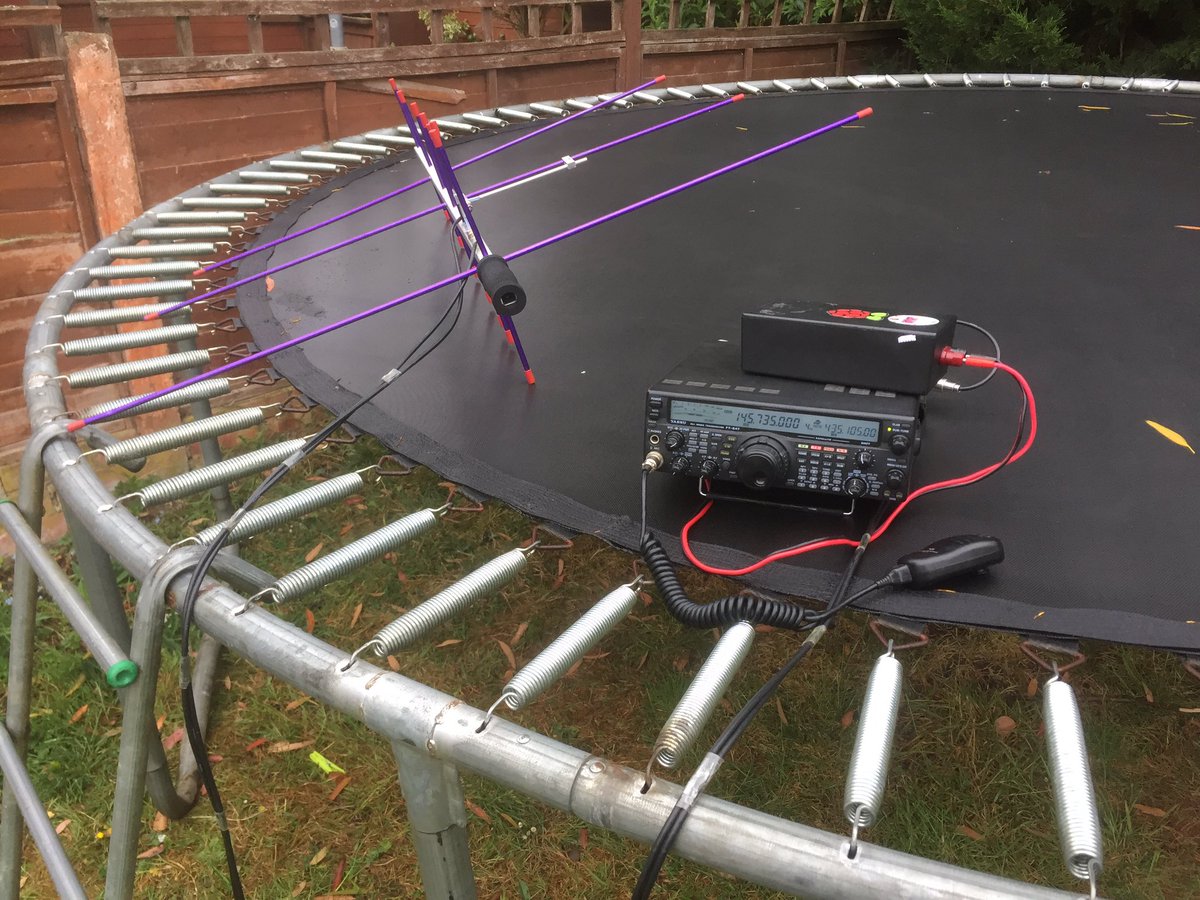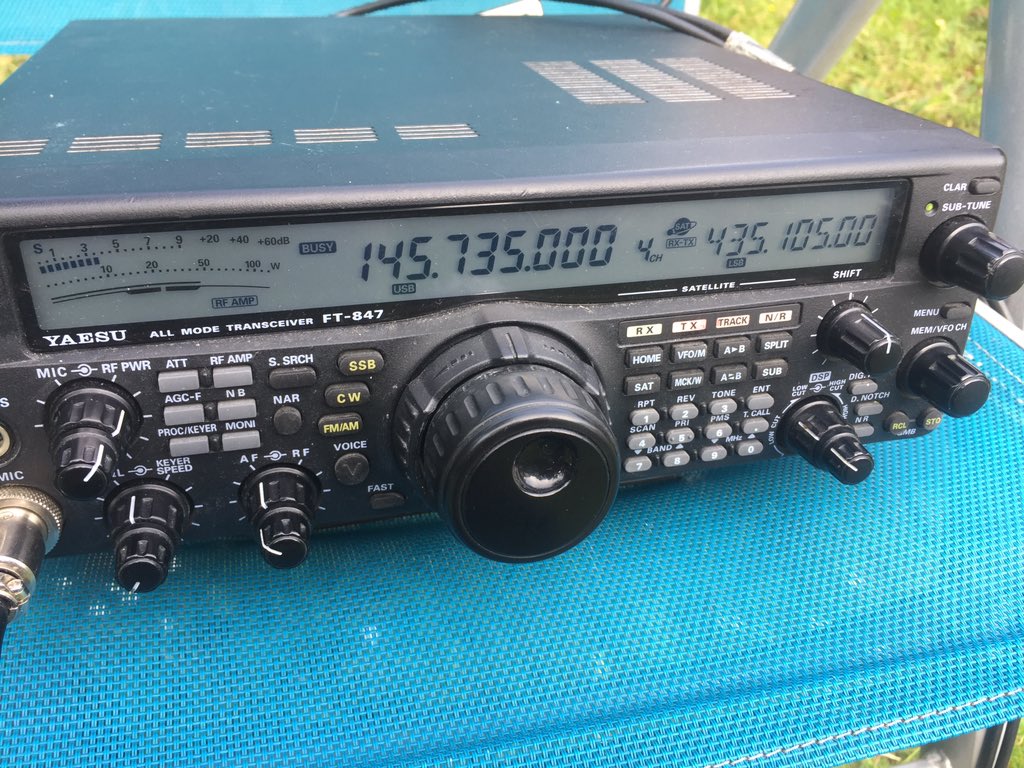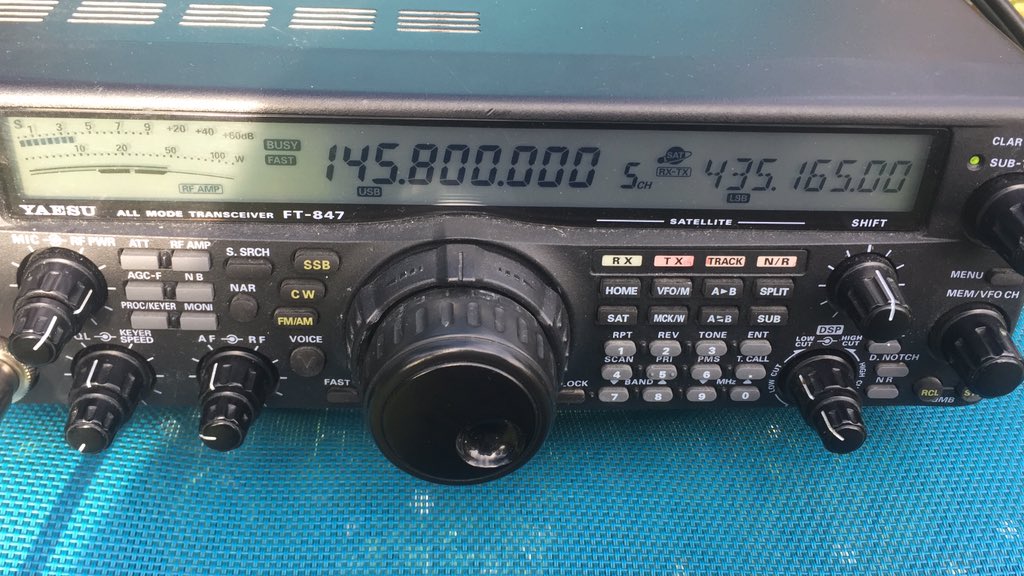Wednesday, 5 April 2017
Monday, 3 April 2017
New May #Vbuildathon **Homebrew Satellite Antenna and Diplexer**
We are hosting our second virtual build a thon in May, this time we will be exploring Satellites and how to get on them and use them.
Firstly, how about building a simple and cheap dual band yagi antenna and diplexer which you can use with your existing hand held or more expensive radio.
We will be using WebEx again, so you will need access to a laptop / PC or tablet (phone) Internet connection and a webcam if you want to be seen, a headset may also be useful.
Please register your interest by e-mailing us: jamesm0jfp@virginmedia.com
The course is FREE of charge and we will look to source the parts for the project and resell them at cost price, once we have an idea of how many are joining in.
We are looking forward to hearing from you soon
Chertsey Radio Club MX0MXo
Firstly, how about building a simple and cheap dual band yagi antenna and diplexer which you can use with your existing hand held or more expensive radio.
We will be using WebEx again, so you will need access to a laptop / PC or tablet (phone) Internet connection and a webcam if you want to be seen, a headset may also be useful.
Please register your interest by e-mailing us: jamesm0jfp@virginmedia.com
The course is FREE of charge and we will look to source the parts for the project and resell them at cost price, once we have an idea of how many are joining in.
We are looking forward to hearing from you soon
Chertsey Radio Club MX0MXo
Wednesday, 29 March 2017
SSB Ham Radio Satellites a beginners guide
This page was last updated 31/May/2019 after a lot more experimenting and success in making SSB contacts.
The old page has been save here

XW-2A https://t.co/XqO9u0aDmO Contact with f5mse in Normandie France

XW2-B https://t.co/2XOgQCJdmt with LA7XK in Norway

XW-2C https://t.co/NlXUCs8Om7 Contact with Italy call IZ5ILX
XW-2F
https://www.dropbox.com/s/8gpzy2y0ppsvzbi/Xw2f%20gb1dd%20%20%20EI8JB-trimmed.m4a?dl=0
FO-29
https://www.dropbox.com/s/a6mkn7iqoguroa5/Fo29-trimmed-1.m4a?dl=0
CAS4A
https://www.dropbox.com/s/wka6jzwgevph7qe/Cas4a%20gb1dd-trimmed.m4a?dl=0
CAS4B
https://www.dropbox.com/s/kwpvlyrsqiw1el0/dg0er%20cas4b.m4a?dl=0
The old page has been save here
2019 An SSB Satellite Odyssey
So over the last month I have at long last had some time to play with my old and trust Ft-847 radio and make several successful SSB contacts.
I'm going to share the process I used to make these contacts and continue to update this page as I gain more experience.
This is for manually tuning / simple portable use.
Equipment
Yaesu FT-847
2 / 70 arrow antenna (short one...not alaskan)
I run 2 lengths of coax one end with BNC (to the arrow antenna) and the other end 1 N-type (70cm port of radio) and the other a PL259 (2 meter port of the radio)
No filters or diplexers used.
I also have a lipo battery in a box (more here)

Set up and preparation
Set power to low, and move up a little if needed!
I spend a little time programming the radio
I spend a little time programming the radio
In the standard memory of the Ft-847 I set up the beacon frequency of several SSB satellites.
In the satellite memories of the Ft-847 I set up the TX and RX suggested frequencies
Have a look here on how to program the memories
Beacon frequencies
FO-29 435.795
AO-73 145.935
XW-2A 145.660
XW-2B 145.725
XW-2C 145.790
XW-2D 145.885
XW-2F 145.975
CAS-4A 145.855
CAS-4B 145.910
EO-88 145.940
EO-79 145.840
I would suggest before trying a voice contact, practice tracking and finding the beacons, get used to moving the antenna and tuning the radio for doppler
For an idea of what you are likely to hear take a look at the videos here
Satellite voice frequencies
Name RX TX
FO-29 435.820 145.980
AO-73 145.954 435.146
XW-2A 145.670 435.045
XW-2B 145.735 435.105
XW-2C 145.800 435.165
XW-2D 145.866 435.224
XW-2F 145.986 435.344
CAS-4A 145.870 435.220
CAS-4B 145.925 435.280
EO-88 145.980 435.025
EO-79 145.950 435.050
First contact
I use a satellite tracking program called GoSatWatch (runs on IOS) there are many variations for all phones, find one that works for you, they all do pretty much the same.
Set up your app to track the above 11 satellites. The application will give you an idea of the direction the satellite is travelling and at what angle, your job is to point the antenna at the satellite and follow its movement across the sky, ssb seem to move more slowly than FM to me.
Set up the radio, set the memory to the beacon frequency of the satellite you want to use, tune a little up and down whilst pointing the antenna in the general direction, once you find the beacon get used to which way the satellite is moving and try find a place to rest the antenna (pointing at the satellite, I used a garden chair) this gives you a spare hand to use! now swap to satellite memory of the radio (transmit and receive frequencies) Start your CQ call, you will adjust the RX frequency until you hear yourself on the downlink. you will need to move the RX frequency constantly as you transmit to keep up with the doppler change.
It takes a bit of time to find yourself, what I did was tune the RX frequency down and up to try find myself, if I got lost, I turned the memory knob to go back to default satellite memory (tx / rx) and started again. You may also want to swap back to standard memory and listen again for the beacon to ensure you are still pointing the antenna in the right direction.
My very first full duplex XW-2A contact (which really took me by surprise) 2 contacts
Have a listen here I worked F4DXV and G0ABI
I then tried XW-2C and as you here at the start of the audio, the power was way too high.
I was able to hear myself on the downlink and as you hear it's hard to keep it steady!
eventually after a few calls I got ON7CL Take a listen here
Next level
I took a risk and ran special event station GB1MIR and managed to work a few more stations on SSB satellites.XW-2A https://t.co/XqO9u0aDmO Contact with f5mse in Normandie France

XW2-B https://t.co/2XOgQCJdmt with LA7XK in Norway

XW-2C https://t.co/NlXUCs8Om7 Contact with Italy call IZ5ILX

XW-2F
https://www.dropbox.com/s/8gpzy2y0ppsvzbi/Xw2f%20gb1dd%20%20%20EI8JB-trimmed.m4a?dl=0
FO-29
https://www.dropbox.com/s/a6mkn7iqoguroa5/Fo29-trimmed-1.m4a?dl=0
CAS4A
https://www.dropbox.com/s/wka6jzwgevph7qe/Cas4a%20gb1dd-trimmed.m4a?dl=0
CAS4B
https://www.dropbox.com/s/kwpvlyrsqiw1el0/dg0er%20cas4b.m4a?dl=0
ssb satellite practice
Check the satellite status first
To check the status / mode of a satellite, please use this link http://www.amsat.org/status/Some satellites switch between data and transponder (repeater) modes.
This will save disappointment when all you hear is data, when you wanted a qso, or vice versa.
Note these SSB satellites DO NOT use CTCSS tones
You can download a chirp file here
In the charts below you will notice that transmit (UP) is always lower side band (LSB)
So it makes sense that Receive (DOWN) is always upper side band (USB)
It is highly recommended, if not required when operating SSB satellites to use 2 radios so you can hear your downlink, and not tread on anyone's toes or cause interference. It will also greatly help find your in and out frequencies.So please be considerate, operate well, listen lot's.
If you do not have 2 radios for full duplex operation, it is possible to work satellites using semi-duplex. However this is reserved for expeditions, or rare occasions where 2 radios is just not practical. Its frowned upon in the satellite community and causes issues.
These issues as you will hear frequently on the FM satellites include the operator calling CQ repeatedly and not able to hear the reply or calling out over the top of someone as there were not aware they were there. Just like on a normal repeater these habits are bad practice and cause frustration to others users, imagine missing that rare square or locator due to someone shouting cq over the top of you and just as the satellite pass finishes.
DON'T call CQ, listen and respond, if no one is around call sign sat (call /sat...)
a general qso is hello call, this is call your signal report 5/9 my locator IO67AS.
Short and simple, should be able to get a few in one pass, but if you have to ask the operator to repeat this takes up valuable time.
If you really have the need to work semi-duplex (Please don't)
How do I set the radio up to do split frequency / mode?
We only have access to a Yeasu 817 and 859, so We will include the instructions below, happy to add more makes and models as needed if it helps.Yeasu 857D and Yaesu 817
Press the [FUNC] key momentarily, then rotate the SELECT knob, as needed, until Multi Function Row “a” [A/B, A=B, SPL] appears on the display.
Now press the [A](A/B) key to toggle between the “A” and “B” VFOs.
As an example for FO-29 set VFO "A" as 435.850 LSB Down / receive
Press [A](A/B) will move you to VFO B and set the frequency to 145.950 USB
Press [A](A/B) again to return to the VFO A
Press [C](Split) do a test TX and check that you RX on 435 and TX on 145
You are now ready to try Sats, change the up / down frequency for each Sat
Listen several times before you attempt to transmit
As with all good radio practice, get used to the new mode and operating style before attempting a CQ call or QSO. SSB satellites are a little bit tricky to receive initially, especially if you are going to tune manually (which we are). Using your favorite satellite tracking software work out where about the pass is, and point the antenna in that general direction. Using our example of FO-29, start at 435.850 and tune *slowly* either side of that until you hear a qso, this may be Morse or Voice. See how the signal drifts up or down the band, tune to adjust for this (Doppler effect). Get used to this slow tuning technique, it will be needed in the next stage when you are ready to transmit.— Chertsey Radio Club (@chertseyRC) March 21, 2017Peter 2e0sql on FO-29 its not easy initially tuning !
FO-29 #morse 7:49 pass 27 degrees pic.twitter.com/N2A9njdky6— Chertsey Radio Club (@chertseyRC) March 21, 2017
Morse code heard on FO-29
Attempting your first SSB QSO on Satellite
Once you have a good grasp of listening and tuning to follow a conversation, its time to try and call CQ. The charts below give you a rough idea of where you transmit and where you should be heard.On FO-29, you transmit on 145.950 and should be heard around 435.850 +/-
Arranging a schedule with a more experienced sat operator, will be good idea on your initial go, they will be able to find you and respond (thanks Peter 2E0SQL).
So once the satellite is overhead, start calling CQ on the center frequency 145.950, give about 15-20 seconds, this allow the receiver to find and tune in to you. When you stop transmitting listen for a response, tune a small amount either side and see if you can find someone calling back to you.
Following what is referred to as, click the link for an in depth discussion, the one true rule
The best approach is to tune on the higher frequency band (UHF / 70cm / 435.x)
For FO-29 and AO-7 (Mode A),You will adjust RX frequency, as this is the higher frequency used.
If you get a response, put into practice what you learnt above and tune slowly to get the best reception.
However, on the other satellites where the Frequencies are reversed we need to tune the TX frequency as this is on the higher frequency
Using the charts below, they help give you a rough idea of where you TX and where you should be heard.
Bob M6FLT and Ian 2E0IPP at Windsor Castle having just worked FO-29, 5 watts Yeasu 817 and arrow antenna.
We want to hear how you get on
We are keen to hear how you get on tracking and working satellites and would be happy to share pictures, sound recordings and videos. We are on Twitter @chertseyrc and via e-mail jamesm0jfp@virginmedia.comHere are several charts to help you with the SSB satellites kindly provided by Paul K5PAV
Thursday, 23 March 2017
SO-50 and Fo-29 Satellite passes at Windsor castle
Shot of Windsor Castle our /p for the night
Ian and Bob after the FO-29 pass
Have a listen to the recording here: https://drive.google.com/file/d/0B_1dHk8Yo754Z3ZsV29pZkc1TWc/view
Subscribe to:
Posts (Atom)


















